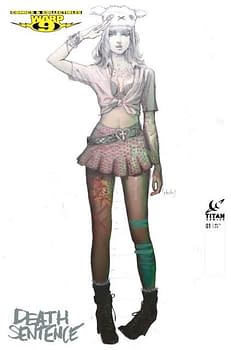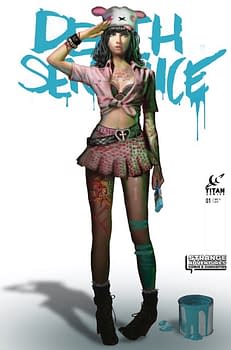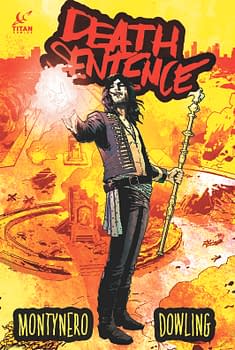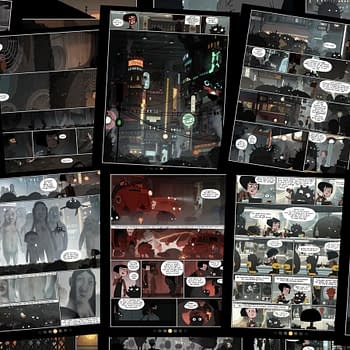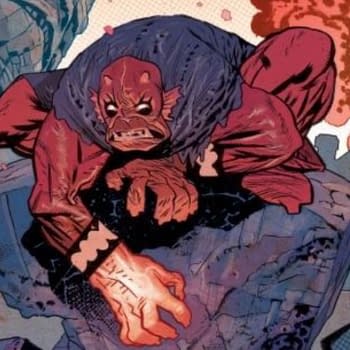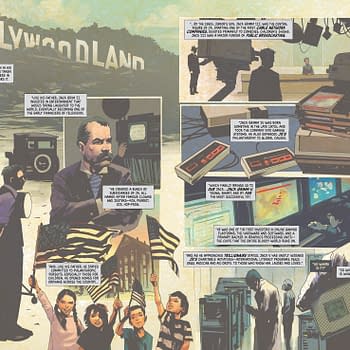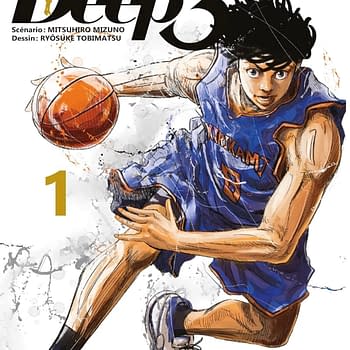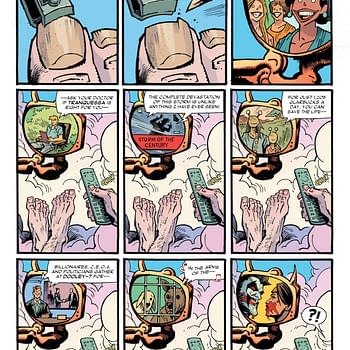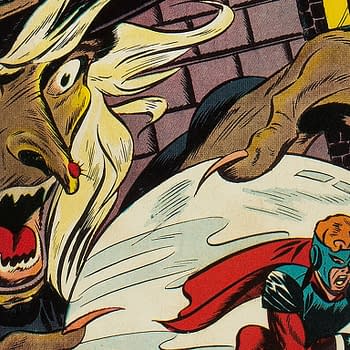Posted in: Comics | Tagged: Comics, death sentence, entertainment, exclusive, monty nero, retailer covers, variant covers
Why Variant Covers Matter
Monty Nero writes,
A couple of weeks ago Image dropped the news they're only doing store specific variant covers for trade collections. Their statement paints variant covers for regular monthly comics in a rather negative light, so I thought it might help to outline another perspective. As a writer and comic artist for a creator owned comic my contribution to the market is small, but that's the point. The perspective from down here may surprise you.
I should clarify that this is purely my opinion, and not that of my esteemed publisher or any of the comic shops I've been talking to. Most comic retailers wanted to remain off the record, but those happy to be quoted are attributed appropriately.
I've got two interests here: firstly as a consumer and buyer of comics, and secondly as a creator. As a customer I just want the story I've paid for with the cover I've seen advertised. I'm not a collector, though I am a hoarder. That means I have pretty much every comic I've ever bought somewhere round the house (or the attic) but I've never sought out more than one copy of a comic. The story is the main thing, for me. I just want the cover to look great and tell me about all the cool things that wait inside.
Not everyone's like me, so as a creator I take a healthy interest in what other people want. To that end I recently invited over 600 different shops and readers to feedback on our four different variant covers. The responses I got back were surprising, and varied:
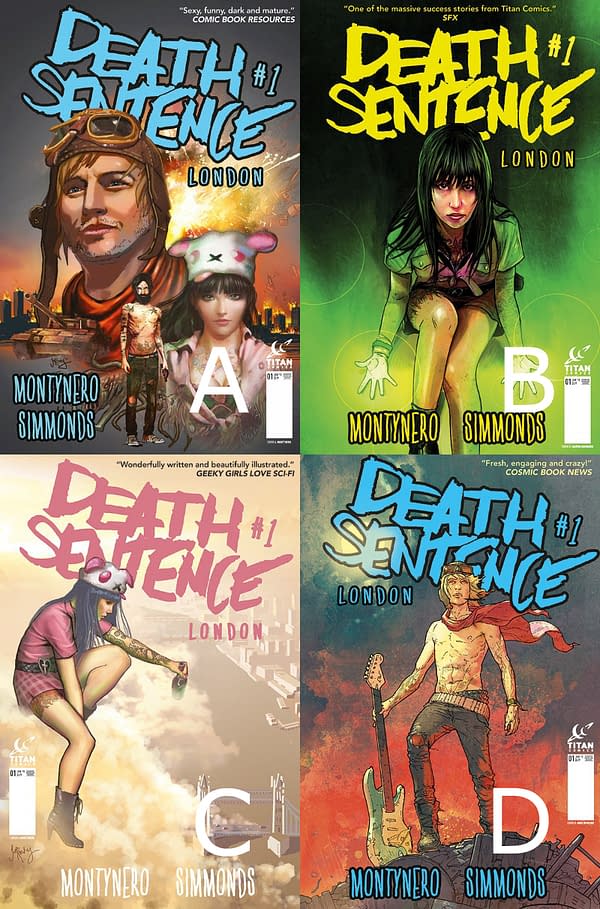
I'm very interested in selling comics to the general populace, to people that haven't read a comic for years, and it's clear that variant covers baffle a lot of new customers. A lot of the jargon and process surrounding the buying of comics is initially quite off putting, which is why I'm not using any here. I was faintly annoyed when the cover to Multiversity: Pax Americana #1 that I mail ordered recently had a different cover to the one I was expecting, but I knew enough about the industry to understand why it happened. A first time buyer wouldn't. Though to be honest by the time I'd read the comic I didn't care because the story was so brilliant I was simply thrilled to own it.
One new reader who contacted me recently went into a comic shop and expressed interest in a new comic. He was directed to the racks and excitedly picked up a few copies of it. When he got home he was annoyed to find all the comics were exactly the same, but with different covers. It's an easy mistake to make if it's your first time in a comic shop and the staff aren't being helpful.
I gave myself a crash course in selling comics when I started self-publishing Death Sentence, and the more I learnt the stranger the business seemed. One thing I did figure out was publishing and selling comics is a full time job, which is why the excellent Titan Comics publish Death Sentence these days. I concentrate on writing and painting the covers, trusting Titan's estimable staff to do their job while I do mine. I do a lot of promotion for Death Sentence through interviews, signings, or social media, but that's standard practice for a writer.
When Titan first published our comic in 2013 "variants" weren't in my thoughts at all. I'd heard the term, and was dimly aware that this meant that sometimes there were different covers for the same comic, but I'd never really taken any notice of how it worked. As a customer I'd always bought the 'proper' cover, considering anything else to be chaff. The general impression I had at that point was that doing more than one cover would somehow increase sales, which was a good thing for everyone.
I didn't give it much thought because I was incredibly busy getting the actual comic ready. As a brand new title from a no-mark first time writer I was naturally worried no-one would buy the comic at all. Co-creator Mike Dowling and I had put years or painstaking effort into telling our story and we just wanted people to read it. I also wanted the comic to appeal to any customer and not just existing comic fans. So I spent a lot of time going back and forth with Titan to make sure the cover art, fonts, colours and design work had the anarchic, contemporary feel I was after. By the time that was all over, there wasn't much time to consider variants.
Of course, we didn't have any spare cash to hire anyone to do variant covers for us. I often joke that I only do the Death Sentence covers because I'm cheap but the fact is I volunteered to do them all for free. The payment was seeing something pretty on sale that we made, and hopefully selling a few more copies if we were lucky.
I did a few cool paintings of Verity, our lead character and cover star, and I had some pencil sketches scanned in, so we used those as a basis for the variants. I found the actual design part of doing a variant cover great fun. You don't have to worry about incorporating the logos and restrictive cover furniture. You can be more experimental and show different facets of the characters or the world. The variant covers for Death Sentence are my favourites, the one's I display in my room like a painting. So creatively, variants are a good thing which is the point of the whole enterprise. Our big hope at that stage was maybe not losing any money while getting the chance to express ourselves.
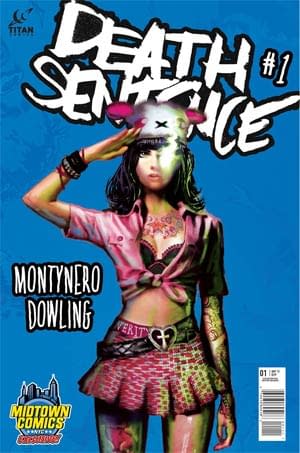
When I found out that some shops around the world were ordering 500 to 1000 copies of a store specific variant cover I was ecstatic. For an enterprise of this scale, a single order of that size is earth shaking. To give you an impression of just how big a deal it was back then, one shop just ordered more copies of Death Sentence than I'd sold self-publishing on my own for a year. That's the advantage of using an established publisher and distributor. I'll always be grateful to Titan, Strange Adventures, Hastings, Midtown Comics, Forbidden Planet, and Warp 9 for taking a chance on something brand new.
Warp 9 variant, Strange Adventures variant, Hastings variant
We only did variants for issue 1, but by the time all the orders for the six issues series were added up Death Sentence had made a healthy profit based on the single issues alone. That was fantastic news, because it meant we could keep on making the comic. There are all kinds of reasons why we sold as many as we did (the comic itself reviewed incredibly well) but there's no doubt that the five store specific covers we did for issue 1 played a positive role in our success too.
If brand new creators with fresh ideas can make creator owned comics without compromising their vision, or selling their rights, then that's got to be good for the industry as a whole. In my experience the extra sales from a few variant covers can give you the creative freedom and independence to take risks and tell an interesting story. There are all kinds of ways to finance a comic these days but surely selling comics to comic fans through comic shops is the best solution for everyone.
What I've discovered in recent months is that some people love getting variant covers; some people love making them; and some people love selling them. I'm not talking about commerce here; I'm talking about people doing what they enjoy because it's fun. Most of the people I've met in the comics business do it because they love it, whether they run a shop, a publisher, buy comics or draw and write – so the 'having fun' part makes it all worthwhile. A lot of retailers simply love getting something unique from a creator they admire. People that don't like variant covers can presumably buy their comics without being affected by any of this, just like I used to. As long as it doesn't get out of hand, in terms of the percentage of comics sold that are variants, there's a lot to enjoy.
But there is another side to the story. The Image press release suggests that "these variants only serve to further feed the speculation market, artificially inflating first issue sales, and thereby doing little to positively affect a series' long term health"
That's true in many respects, though it sure doesn't damage a comic's long term health either. If the sales of your first issue can help make the whole series viable then that is very much a positive for the creators and fans involved. And an issue 1 that makes a big sales splash generates a lot of positive publicity. A lot of creator owned comics these days are initially planned as mini-series, so selling a lot of copies of the first issue can potentially make the difference between the whole enterprise losing money and turning a profit. I think we're all on the side of creators getting paid for their time, so turning a profit is important. And if new ideas from brand new creators consistently lose money, then eventually there won't be any. Then the industry really would be in trouble.
When you start out as a creator you're eking out sales one by one because margins are very tight. In sales terms it doesn't really matter how good your comic is at the very beginning of your career because no-one's heard of you. Comic sales to stores happen two months before the comic comes out (that's one of the tricky things about the business I mentioned earlier). Retailers have to buy the comics in before they sell them on, so they're naturally reluctant to order an unknown product from unknown parties for exactly the same reason you don't order things off the internet from people you've never heard of. People buy what they like from people they trust. So anything that encourages comic stores to buy in a brand new comic from new creators is helpful. The quality of your work is something that gains sales traction over time, whereas a great cover unique to a single store can have an instant impact. If you're lucky enough to build up a big audience, and gain the trust of retailers, then maybe you can take a different approach later. Which is what Image have done.
Chad Boudreau, owner of ComicReaders Downtown in Regina, Saskatchewan, Canada, offers this opinion:
I don't think Image's decision will impact the speculator market but it will probably affect their market share— that Holy Grail where all other publishers are trying to chip away at the grip Marvel and DC have. I like to think that the increases Image has enjoyed in market share in the last year or more is because they are putting out enjoyable, intelligent comics that appeal to a wide range of readers but perhaps the variants have been a part of that too. I hope not though. I hope Image sales are on the rise because of an increased number of READERS. In my store, Image Comics sell very well. Sell to readers. Not speculators."
And later he adds:
Variants for trade paperbacks is no different than variants for comics, isn't it? Why cancel exclusive program and create another? Does Image get a bigger flat fee for trade paperback sales? I initially applauded Image for their decision to get rid of the exclusives but they haven't really done so have they?"
As to the 'speculation market' I must confess I don't really understand it and it's never affected my personal buying habits. Death Sentence attracted some speculator interest, which surprised the hell out of me at first. But as I looked into it I realized it was a high quality low print run comic with a lot of positive buzz, which is exactly the sort of comic people might be able to actually make money from.

A quick Google reveals that the variant Forbidden Planet cover to Death Sentence issue 1 regularly sells for fifty bucks or more these days. Wow! It was four bucks when it came out. From my point of view I'm glad people think something Mike and I made is valuable. I'd encourage everyone to buy it in a comic shop when it comes out at cover price, because you don't want to be paying over ten times more for it later on.
The type of variant monthly comic I've described so far, which we did for issue 1 of the first Death Sentence series, is the store specific type. Store specific means only one shop sells it. One snag with this kind of variant cover is that you generally have to be relatively close to the store in question to get it. For example, some of our readers in the UK wanted the American store variants and vice versa. Some of these stores delivered worldwide but even then the cost of shipping was fairly prohibitive for people on another continent.
For the new Death Sentence London series Titan decided on a different system. The advantage of this system was that any store in the world could get all the covers, which solved the problem I just described. The way this works is that shops can order as many copies of cover A and B as they like, and then get a copy of covers C and D for free with orders above a certain modest level. Shops set the price of cover C and D at whatever price works for them.
I'm told this is the most common way variant covers are solicited for sale, because it can help to drive orders up. To that end a big publisher recently offered a 1 in 700 variant, meaning a shop had to order 700 extra copies of a comic just to get one unique copy. To offset that risk shops were offering the single issue for sky high prices, which meant you could soon find it on sale for five grand. It probably made a collector very happy, but where are those 700 other comics now? Under this system, it doesn't really matter in the short term. Here's Chad again:
Increased sales by means of exclusives and incentives DOES NOT increase readership. The comics industry needs MORE READERS not more gimmicks…When I'm ordering a trade paperback (and graphic novel and comics) I take a number of things into consideration: Who is writing it; who is drawing it; what is the advance interest from my customers; is it generating some buzz online and offline; can the story possibly appeal to a diverse audience; is it a story I've not seen told a hundred times already; but I would never think "Can I sell this exclusive for fat cash if I order this crap tonne of copies that will never sell."
One problem with this type of variant is by the time you've explained to most customers what cover A, B. C. and D looks like, plus the ordering rules, their eyes have glazed over. Another problem is most comic shops listed just two of the four comic covers for preorder which is frustrating for readers that want the other two. If they want cover C or D they'll have to hunt around for it on June 10th and hope to get lucky. Another issue is that many shops charge customers the full cost of however many comics they had to buy to get the free one. On the other hand, I saw that one shop only charged a dollar or two more to preorder it. When Mike and I painted these covers I'd naively assumed they'd all be on sale for the regular price. You live and learn.
I don't know about you, but my interest in buying things only stretches so far. If buying something I want becomes too much of a ballache I give up fairly quickly. I'll happily click on a link and spend my cash, or go into a store to pick up my comics and buy them on the spot. I sometimes preorder new things from creators I know I love, but that's the exception not the rule. I don't generally plan my reading purchases months in advance, which is what preordering new comics and their variants necessitate. I'm not overly motivated to identify which cover is A, B. C, or D either. And if someone told me the cover I wanted was ten times the price of the normal cover, I'd just buy the normal cover instead.
But many people feel differently to me. I've got nothing but love for the joyful enthusiasm of someone who likes a comic so much that they want to seek out a particularly cool copy of it, or get them all. Readers who love your work to that extent are genuinely inspiring, and on a comic of our size we know many of them by name. The mutual respect and trust we've built up means we don't do too many variants and try to make sure they're as widely and easily available as possible. We consult them on the kind of things they'd like to see and give them free stuff from time to time too, like original comic art or rare art cards, through our readers group.
For most fans it's a wholly positive passion, but a small percentage of readers have told me that they have a love hate relationship with buying comics in general. Where a company has done a really big number of variants they sometimes feel manipulated into spending too much:
they usually lead to me spending too much on comics, which can get me into trouble with my wife and I hate the feeling of shame that I have when she confronts me about my overspending on comics. It is a very compulsive thing for me and I find it really hard to resist that completist urge"
But the same person enjoys the positive side too:
I like the idea that buying variants may help the creators out. I love getting blank cover variants because I love getting artists at comic cons to sketch on them. I love getting variants of certain artists whose work I really admire (Jenny Frison anyone!). I have learned the hard way to work on resisting my "gotta get 'em all" urges, but every Wednesday that challenge is revisited."
If we extrapolate the comics ordering system to food we can see how counterintuitive it is for new readers. Can you tell me which flavor of yoghurt you want to eat in two months' time? Are you happy to pay for it today even though you won't eat it for another 60 days? Not really. Consumers generally value 'one click' convenience and want their stuff now, whatever the market. In contrast the relative difficulty of getting this stuff seems to make it more attractive to hardcore fans and collectors.
Retailer's attitudes to variants are disparate: Get Ready Retro, from Kent in the UK, tell me that
"Variants tend to only sell well (with our customer base) if it's themed rather than a variant to do with the comic. For example, the latest DC Comics movie variants sold extremely well and there is a huge demand for the Joker variants but aside from this – variants don't tend to shift too quickly unless they are 1:100".
Another retailer tells me 1:10 variants are great, because it helps sell a few extra copies and rewards ordering them with something free. Another describes how most of their customers couldn't care less about variant covers because it's a collectors market, a small specialist crowd. A lot of retailers tell me they love variants of all kinds and like to keep their regular customers happy whatever that entails (hello!); another says that if a stranger rings up asking them to order x number of comics just to get a variant they are reluctant to do so because they don't know or trust them. Some retailers tell me they hate store specific variants, and some retailers tell me they don't like the 'order x comics to get a unique variant' system. It's hard to keep everyone happy.
Some retailers I've spoken to are genuinely worried that too many variant covers will lead to the collapse of the comics market in general, like it did in the nineties. You can understand their concern as their livelihood is on the line. What that means in practice is they'll sell variants to customers while issuing dark warnings about it. Some retailers also project their frustrations onto the creators occasionally. I think one reason might be that this is a system that involves the creators, the publisher, the distributor, the shop, and the customer in turn. No single party is in charge of how each comic is sold, so if something's happening that they're not happy about it's easy to assume the other party must be at fault. But empathy works both ways: If I can understand why many comic shops set prices for variants so high, then surely they can understand why we want to make a few different covers from time to time. My impression is that there's a lot that happens in the comics business that nobody is particular happy about, things you could only sort out by representatives from each link in the chain meeting together to sort out a better system. Maybe it'll happen one day.
Until then the best thing is for publishers like Image to take a leaf from Spider-Man's book and use their variant powers with great responsibility. So in that spirit I welcome their decision. It's just not the right call for everyone.
Death Sentence London #1 is out June 10th from Titan Comics.


